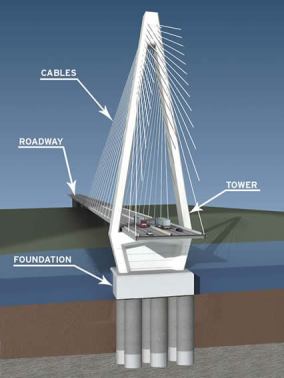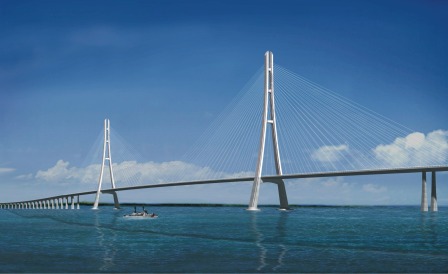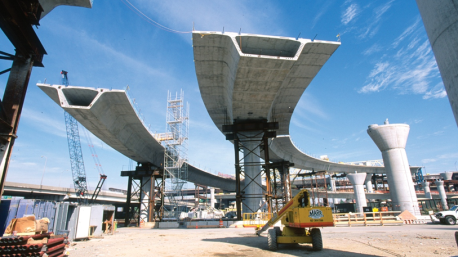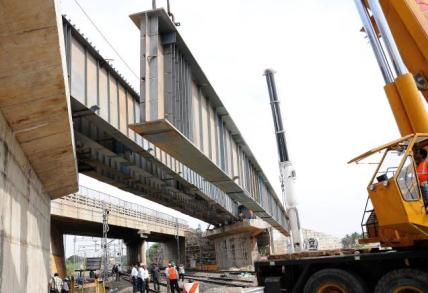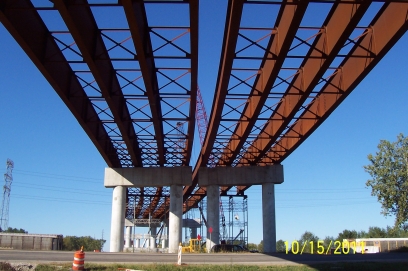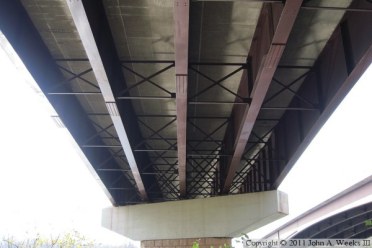First published in Concrete International Magazine, March 2009
Generally, it’s most economical to place wall footings at a constant elevation. If the site or finished grade slopes along the length of the wall, however, the footing may end up a considerable distance below finished grade. This is clearly not economical, as it requires extra excavation and material. Two other options are therefore preferred (Fig. 1):
- Slope the footing with the site so its depth below the finished grade is nearly constant along its length; or
- Step the footing so its depth below finished grade is not excessive at any point along its length.

SLOPED FOOTING ISSUES
The sloped footing option may seem appealing because of the simple geometry and apparent ease in formwork construction. It does, however, create the following construction issues (Fig. 2):

- Vertical wall bars above the footing will have different lengths, creating major challenges in the fabrication plant and on the job site. Two of these—managing the inventory and placing the bars in their correct locations— can be eased by detailing the bars with variable lap splice lengths. This will, however, increase the quantity of vertical reinforcement;
- Horizontal reinforcing bars in the lower portion of the wall will also have different lengths because they are interrupted by the sloped footing. If constant length horizontal bars are used at the wall base, they can be fanned out, but this will create a variable vertical spacing of the reinforcing bars;
- Sloped footings will require trapezoidal formwork. This will require modifications to standard rectangular formwork;
- A sloped footing could be unstable, particularly on a very steep slope; and
- Concrete placement and finishing could be difficult, and a stiff concrete mixture might be required to prevent the concrete from flowing downhill, which may lead to segregation. Alternatively, the top of the form may have to be closed.
Because of these challenges, most engineers and contractors prefer to use stepped footings instead of sloped footings.
CONSIDERATIONS FOR STEPPED FOOTINGS
As with any aspect of a design, cost should be considered before a system is selected. If the slope of the finished grade is less than 2 ft (0.6 m) for a 20 to 30 ft (6 to 9 m) long wall, a lower but constant bottom bearing elevation may be more economical than a stepped footing. For a very long wall, however, even a 1 ft (0.3 m) variation in the site elevation may make a stepped footing more economical. Communication with the contractor during the design phase regarding the number and length of steps can be very helpful.
It’s generally more cost effective to minimize the number of steps. For example, it may be more economical to design for a 6 ft (1.8 m) change in elevation using three 2 ft (0.6 m) steps or two 3 ft (0.9 m) steps rather than six 1 ft (0.3 m) steps. This minimizes the number of wall sections to be detailed and formed. Before deciding on the footing step locations, however, consider the horizontal distance between them. Distances should preferably be multiples of available or standard form lengths.
Before completing a design, it’s a good idea to communicate with area formwork contractors. The horizontal runs should be dimensioned in 2 or 4 ft (0.6 or 1.2 m) increments to conform to standard plywood or form system dimensions. Unless the site slopes drastically, try to keep a minimum horizontal run of 10 ft (3 m) for each step, if possible.
Keep the detailing simple. Avoid using Z-shaped bars (Fig. 3). Their geometry may make it necessary to slant the riser out of plane to meet cover requirements for the treads.

It’s also prudent to evaluate other footing options. For example, the individual spread footings or piers supporting grade beams shown in Fig. 4 may be more economical than a continuous spread footing option. Because the wall can span between footings or piers, similar configurations can be constructed without the grade beam.
Situations can vary along the wall length, so it’s prudent to show specific details rather than generic details. This will expedite placing drawing preparation and perhaps minimize requests for information (RFIs).
CLOSURE
The use of sloped or stepped footings depends on site conditions, finished grade elevations, finished wall slope, and various reinforcing bar placement and construction issues. Regardless of the footing system selected, the engineer is required to follow the design requirements of Section 15.9 in ACI 318-08.[1] Section 15.9.1 requires that the angle of slope or depth and location of steps be such that the design requirements are satisfied at every section. Additionally, Section 15.9.2 requires footings designed as a unit to be constructed to ensure they act as a unit.
Acknowledgments
Thanks to Joint ACI-CRSI Committee 315 member Javed Malik, Jacobs Carter Burgess Engineering, Houston, TX, for providing the information in this article.
References
1. ACI Committee 318, “Building Code Requirements for Structural Concrete (ACI 318-08) and Commentary,” American Concrete Institute, Farmington Hills, MI, 2008, 465 pp.
